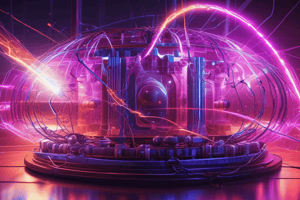Podcast
Questions and Answers
What is electricity a form of?
What is electricity a form of?
- Energy due to charged particles (correct)
- Energy due to moving particles
- Energy due to uncharged particles
- Energy due to neutral particles
What is the main difference between a neutral and a charged object?
What is the main difference between a neutral and a charged object?
- A neutral object has more positive charges, while a charged object has more negative charges
- A neutral object has an equal number of positive and negative charges, while a charged object has an imbalance of positive and negative charges (correct)
- A neutral object has no charges, while a charged object has both positive and negative charges
- A neutral object has more negative charges, while a charged object has more positive charges
What is electrostatic interaction?
What is electrostatic interaction?
- The repulsion between two charged objects
- The attraction between two neutral objects
- The attraction between a charged and a neutral object
- The interaction between electrically charged particles, resulting in attraction or repulsion (correct)
What is the principle behind charging an object by friction?
What is the principle behind charging an object by friction?
What is the electrostatic series?
What is the electrostatic series?
How do anti-cling sheets work?
How do anti-cling sheets work?
What happens when a neutral object comes into contact with a charged object?
What happens when a neutral object comes into contact with a charged object?
What determines the amount of net charge on an object?
What determines the amount of net charge on an object?
What is the main factor that determines the magnitude of the electric force between two charged objects?
What is the main factor that determines the magnitude of the electric force between two charged objects?
What is the purpose of a grounding system?
What is the purpose of a grounding system?
What is the main difference between an insulator and a conductor?
What is the main difference between an insulator and a conductor?
What is the purpose of a lightning rod?
What is the purpose of a lightning rod?
What is the main difference between static electricity and current electricity?
What is the main difference between static electricity and current electricity?
What is an electric circuit?
What is an electric circuit?
What is the purpose of an electrostatic precipitator?
What is the purpose of an electrostatic precipitator?
What is the purpose of induction in charging an object?
What is the purpose of induction in charging an object?
Flashcards are hidden until you start studying
Study Notes
Electricity
- Electricity is a form of energy due to charged particles (electrons moving)
- There are two types of electricity: static and current
Electric Force
- Electrostatic interaction between electrically charged particles
- Amount and direction of attraction or repulsion between charged bodies
- Opposites attract, like charges repel, and neutral objects attract to charged particles
- No charge between two neutral objects
Charging an Object
- Friction: transfer of electrons from one object to another when two neutral objects are rubbed together
- Contact: a neutral object becomes charged when touched by a charged object
- Induction: the movement of electrons in a substance caused by the electric field of a nearby charged object, without direct contact
Electrostatic Series
- A list of materials arranged in order of their tendency to gain electrons
- Materials with higher affinity to electrons take electrons from weaker materials
Static Electricity
- Charging by contact: a neutral object becomes charged when touched by a charged object
- Electric forces: the amount of net charge depends on the difference between protons and electrons
- Electric fields: a property of the space around a charged object where other objects can feel the effect of its charges
- Grounding: an object that can supply a very large number of electrons to or can remove a very large number of electrons from a charged object, thus neutralizing the object
Insulators vs. Conductors
- Insulators: electrons cannot move easily from one atom to another (non-metals)
- Conductors: electrons can move easily between atoms (metals)
Grounding
- Ground can either remove electrons or supply electrons
- Grounding makes induced charges permanent
- What can act as a ground: metals, conductors, and lightning rods
Current Electricity
- Difference between static and current electricity: static charges build up and discharge, while current electricity is a continuous flow of electrons
- Electric circuit: a closed path along which electrons powered by an energy source can flow
- Examples of energy sources: wall outlet, cell, or battery
Electric Circuit
- A closed path -> a loop where electrons flow from and return to the energy source
- Most of the energy in ON comes from hydroelectric and nuclear plants
- Voltaic Cell: a source of energy that generates an electric current by chemical reactions involving two different metals
Studying That Suits You
Use AI to generate personalized quizzes and flashcards to suit your learning preferences.




